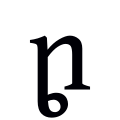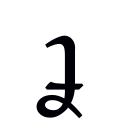Various letters have been used to write the click consonants of southern Africa. The precursors of the current IPA letters, ⟨ǀ⟩ ⟨ǁ⟩ ⟨ǃ⟩ ⟨ǂ⟩, were created by Karl Richard Lepsius[1][2] and used by Wilhelm Bleek[3] and Lucy Lloyd, who added ⟨ʘ⟩.

Also influential were Daniel Jones, who created the letters ⟨ʇ⟩ ⟨ʖ⟩ ⟨ʗ⟩ ⟨ʞ⟩ that were promoted by the IPA from 1921 to 1989, and were used by Clement Doke[4][5] and Douglas Beach.[6]
Individual languages have had various orthographies, usually based on either the Lepsius alphabet or on the Latin alphabet. They may change over time or between countries. Latin letters, such as ⟨c⟩ ⟨x⟩ ⟨q⟩ ⟨ç⟩, have case forms; the pipe letters ⟨ǀ⟩ ⟨ǁ⟩ ⟨ǃ⟩ ⟨ǂ⟩ do not.[7]
Multiple systems


By the early 19th century, the otherwise unneeded letters ⟨c⟩ ⟨x⟩ ⟨q⟩ were used as the basis for writing clicks in Zulu by British and German missions.[8] However, for general linguistics this was confusing, as each of these letters had other uses. There were various ad hoc attempts to create letters—often iconic symbols—for click consonants, with the most successful being those of the Standard Alphabet by Lepsius, which were based on a single symbol (pipe, double pipe, pipe-acute, pipe-sub-dot) and from which the modern Khoekhoe letters ⟨ǀ⟩ ⟨ǁ⟩ ⟨ǃ⟩ ⟨ǂ⟩ descend.

Though not clear from this image, the descenders on the nasal clicks that bend to the right bear rings, while those that bend to the left are tails as in IPA ŋ and ɲ. That is, the nasal click letters are, respectively, n with a ring on the right leg, ŋ with a ring on the left leg, n with a ring on the left leg, ɲ with a ring on the right leg, and n with rings on both legs, or, in the order of the main table,





 .
.During the First World War, Daniel Jones created the equivalent letters ⟨ʇ⟩ ⟨ʖ⟩ ⟨ʗ⟩ ⟨ʞ⟩ in response to a 1914 request to fill this gap in the IPA, and these were published in 1921 (see history of the International Phonetic Alphabet).[9]
In 1875, if not earlier, Wilhelm Bleek used the letter ⟨ʘ⟩ for bilabial clicks.[10] It was also used 1911 by Lucy Lloyd.[11]
Clement Doke expanded on Jones' letters in 1923. Based on an empirically informed conception of the nature of click consonants, he analyzed voiced and nasal clicks as separate consonants, much as voiced plosives and nasals are considered separate consonants from voiceless plosives among the pulmonic consonants, and so added letters for voiced and nasal clicks. (Jones' palatal click letter was not used, however. Jones had called it "velar", and Doke called palatal clicks "alveolar".) Doke was the first to report retroflex clicks.

Douglas Beach would publish a somewhat similar system in his phonetic description of Khoekhoe. Because Khoekhoe had no voiced clicks, he only created new letters for the four nasal clicks. Again, he didn't use Jones' "velar" click letter, but created one of his own, ⟨𝼋⟩, based on the Lepsius letter ⟨ǂ⟩ but graphically modified to better fit the design of the IPA.
| bilabial | dental | lateral | alveolar | palatal | retroflex | |
|---|---|---|---|---|---|---|
| Wuras ms[12] | 8 | ∧ | ⨅ | ∩ | ⅂ | |
| Boyce (1834)[13] | c | x | q | qc[14] | ||
| Knudsen (1846)[15] | ꞏ | ʼ | ʻ | ꞉ | ||
| Schreuder (1850)[16] |  |  [8] [8] |  [8] [8] | |||
| Lepsius (1853) | ǀc | ǀx | ǀʞ | ǀɔ | ||
| Lepsius (1854)[17] | ǀ | ǀǀ | ǀ̣ | ǀ́ [18] | ||
| Bleek (1857) | c | x | q | ɔ | ||
| Tindall (1858)[19] | c | x | q | v | ||
| Palaeotype (1869) | 5 | 7 | ↊ | 4 | ||
| Anthropos (1907) | p | ʇ̯ (ʇ) | ʇ (ʇ̣) | ɔ +velar ʞ | (ʇ̣) | |
| Lloyd (1911) | ʘ | ǀ | ǁ | ǃ | ǂ | |
| Jones (1921)[20] | ʇ | ʖ | ʗ | ʞ ('velar') | ||
| Doke (1925) | ʇ | ʖ | ʗ | 🡣 | ψ | |
| Engelbrecht (1928)[21] | c | x | q | ç | ||
| Beach (1938) | ʇ | ʖ | ʗ | 𝼋[22] | ||
| current IPA (1989) | ʘ | ǀ | ǁ | ǃ | ǂ | 𝼊[23] |
| typewriter substitutions | @ | / | // | ! | = | !! |
| ARA proposal (1982) | ω | ʈ | λ | ɖ | ç | |
| Linguasphere (1999) | p' | c' | l' | q' | t' | |
| Lingvarium (ca. 2005) | пъ | цъ | лъ | къ | чъ |
The African reference alphabet proposal has apparently never been used, while the Linguasphere and Lingvarium transcriptions are typewriter substitutions specific to those institutions.[24]
Besides the difference in letter shape (variations on a pipe for Lepsius, modifications of Latin letters for Jones), there was a conceptual difference between them and Doke or Beach: Lepsius used one letter as the base for all click consonants of the same place of articulation (called the 'influx'), and added a second letter or diacritic for the manner of articulation (called the 'efflux'), treating them as two distinct sounds (the click proper and its accompaniment),[25] whereas Doke used a separate letter for each tenuis, voiced, and nasal click, treating each as a distinct consonant, following the example of the Latin alphabet, where the voiced and nasal occlusives also treated as distinct consonants (p b m, t d n, c j ñ, k g ŋ).
Doke's nasal-click letters were based on the letter ⟨n⟩, continuing the pattern of the pulmonic nasal consonants ⟨m ɱ n ɲ ɳ ŋ ɴ⟩. For example, the letter for the dental nasal click is ⟨ȵ⟩; the alveolar is similar but with the curl on the left leg, the lateral has a curl on both legs, and the palatal and retroflex are ⟨ŋ⟩ ⟨ɲ⟩ with a curl on their free leg: ⟨ ⟩ ⟨
⟩ ⟨ ⟩ ⟨
⟩ ⟨ ⟩ ⟨
⟩ ⟨ ⟩ ⟨
⟩ ⟨ ⟩. The voiced-click letters are more individuated, a couple were simply inverted versions of the tenuis-click letters. The tenuis–voiced pairs were dental ⟨ʇ ɣ⟩ (the letter ⟨ɣ⟩ had not yet been added to the IPA for the voiced velar fricative), alveolar ⟨ʗ 𝒬⟩, retroflex ⟨ψ ⫛⟩,[26] palatal ⟨🡣 🡡⟩ and lateral ⟨ʖ ➿︎⟩. A proposal to add Doke's letters to Unicode was not approved.[27]
⟩. The voiced-click letters are more individuated, a couple were simply inverted versions of the tenuis-click letters. The tenuis–voiced pairs were dental ⟨ʇ ɣ⟩ (the letter ⟨ɣ⟩ had not yet been added to the IPA for the voiced velar fricative), alveolar ⟨ʗ 𝒬⟩, retroflex ⟨ψ ⫛⟩,[26] palatal ⟨🡣 🡡⟩ and lateral ⟨ʖ ➿︎⟩. A proposal to add Doke's letters to Unicode was not approved.[27]
Beach wrote on Khoekhoe and so had no need for letters for the voiced clicks; he created letters for nasal clicks by adding a curl to the bottom of the tenuis-click letters: ⟨𝼌 𝼏 𝼍 𝼎⟩.
Doke and Beach both wrote aspirated clicks with an h, ⟨ʇh ʗh ʖh 𝼋h⟩, and the glottalized nasal clicks as an oral click with a glottal stop, ⟨ʇʔ ʗʔ ʖʔ 𝼋ʔ⟩. Beach also wrote the affricate contour clicks with an x, ⟨ʇx ʗx ʖx 𝼋x⟩.
Transcribing voicing, nasalization and the velar–uvular distinction
Doke had run "admirable" experiments establishing the nature of click consonants as unitary sounds. Nonetheless, Bleek in his highly influential work on Bushman languages rejected Doke's orthography on theoretical grounds, arguing that each of Doke's letters stood for two sounds, "a combination of the implosive sound with the sound made by the expulsion of the breath" (that is, influx plus efflux), and that it was impossible to write the clicks themselves in Doke's orthography, as "we cannot call [the implosive sounds] either unvoiced, voiced, or nasal."[28] Bleek therefore used digraphs based on the Lepsius letters, as Lepsius himself had done for the same reason. However, linguists have since come down on the side of Doke and take the two places of articulation to be inherent in the nature of clicks, because both are required to create a click: the 'influx' cannot exist without the 'efflux', so a symbol for an influx has only theoretical meaning just as a symbol like ⟨D⟩ for 'alveolar consonant' does not indicate any actual consonant. Regardless, today separate letters like Doke's are not provided by the IPA (or other systems), and linguists resort to diacritics that would not be used for non-click consonants. (For example, no-one transcribes a alveolar nasal stop [n] as ⟨ⁿt⟩ or ⟨t̃⟩ analogous to the way one writes a dental nasal click as ⟨ⁿǀ⟩ or ⟨ǀ̃⟩ in current IPA or as ⟨ⁿʇ⟩ or ⟨ʇ̃⟩ in pre-Kiel IPA.)
Summarized below are the common means of representing voicing, nasalization and dorsal place of articulation, from Bleek's digraphs reflecting an analysis as co-articulated consonants, to those same letters written as superscripts to function as diacritics, reflecting an analysis as unitary consonants, to the combining diacritics for voicing and nasalization. Because the last option cannot indicate the posterior place of articulation, it does not distinguish velar from uvular clicks. The letter Ʞ is used here as a wildcard for any click letter.
| Velar | Uvular | |||||
|---|---|---|---|---|---|---|
| Tenuis | Voiced | Nasal | Tenuis | Voiced | Nasal | |
| Coarticulation analysis | k͡Ʞ | ɡ͡Ʞ | ŋ͡Ʞ | q͡Ʞ | ɢ͡Ʞ | ɴ͡Ʞ |
| Superscript diacritics, unitary analysis | ᵏꞰ | ᶢꞰ | ᵑꞰ | 𐞥Ʞ | 𐞒Ʞ | ᶰꞰ |
| Combining diacritics, unitary analysis | Ʞ | Ʞ̬ | Ʞ̬̃ | |||
A distinction may be made between ⟨ᵏꞰ⟩ for an inaudible rear articulation, ⟨Ʞᵏ⟩ for an audible one, and ⟨Ʞ͡k⟩ for a notably delayed release of the rear articulation; for aspirated clicks these are ⟨ᵏꞰʰ⟩, ⟨Ʞᵏʰ⟩, ⟨Ʞ͡kʰ⟩.
Historical orthographies
Written languages with clicks generally use an alphabet either based on the Lepsius alphabet, with multigraphs based on the pipe letters for clicks, or on the Zulu alphabet, with multigraphs based on c q x for clicks. In the latter case, there have been several conventions for the palatal clicks. Some languages have had more than one orthography over the years. For example, Khoekhoe has had at least the following, using dental clicks as an example:
| Modern | ǀguis | ǀa | ǀham | ǀnu |
|---|---|---|---|---|
| Beach (1938) | ʇuis | ʇʔa | ʇham | 𝼍u |
| Tindall (1858) | cguis | ca | cham | cnu |
Historical roman orthographies have been based on the following sets of letters:
| dental | alveolar | lateral | palatal | |
|---|---|---|---|---|
| Xhosa (1834)[13] | c | q | x | qc[29] |
| Khoekhoe (1858) | c | q | x | v |
| Juǀʼhoan (1987–1994) | c | q | x | ç |
| Naro (2001–present) | c | q | x | tc[30] |
There are two principal conventions for writing the manners of articulation (the 'effluxes'), which are used with both the Lepsius and Zulu orthographies. One uses g for voicing and x for affricate clicks; the other uses d for voicing and g for affricate clicks. Both use n for nasal clicks, but these letters may come either before or after the base letter. For simplicity, these will be illustrated across various orthographies using the lateral clicks only.
| tenuis | voiced | nasal | glottalized | aspirated | affricated | affricated ejective | voiceless nasal | murmured | murmured nasal | ||
|---|---|---|---|---|---|---|---|---|---|---|---|
| Zulu | > ca. 1850 | x | xg[31] | xn | xh | ||||||
| Khoekhoe | modern | ǁg | ǁn | ǁ | ǁkh | ǁh | |||||
| 1858 | xg[32] | xn | x | xkh | xh | ||||||
| Naro | > 2001 | x | dx | nx | xʼ | xh | xg | xgʼ | |||
| Juǀʼhoan | modern | ǁ | gǁ | nǁ | ǁʼ | ǁh | ǁx, gǁx | ǁk, gǁk | ǁʼh | gǁh | nǁh |
| 1975 | ǁxʼ, gǁxʼ | nǁʼh | |||||||||
| 1987 | x | dx | nx | xʼ | xh | xg, dxg | xgʼ, dxgʼ | xʼh | dxh | nxh | |
| Hadza | x | nx | xx | xh | |||||||
| Sandawe | x | gx | nx | xʼ | xh | ||||||
Gallery
The order of the following systems is the same: bilabial, dental ('c'), lateral ('x'), alveolar ('q'), palatal ('v') and retroflex.
The Zulu click letters of the Norwegian mission:
- c
- x
- q
Lepsius's click letters (lower case; upper case are taller):
- c
- x
- q
- v
Sundevall's click letters (lower case; upper case are similar):
- c
- x
- q
- v
Jones's IPA letters:
- c
- x
- q
- v
Doke's letters for voiceless clicks:
- c
- x
- q
- v
Doke's letters for voiced clicks:
- gc
- gx
- gq
- gv
- gx (variant)
Doke's letters for nasal clicks:
- nc
- nx
- nq
- nv
Beach's letters for voiceless clicks:
- c
- x
- q
- v
Beach's letters for nasal clicks:
- nc
- nx
- nq
- nv
Post-Kiel IPA:
- c
- x
- q
- v
Short IPA glyphs:
- c
- x
- q
- v













































